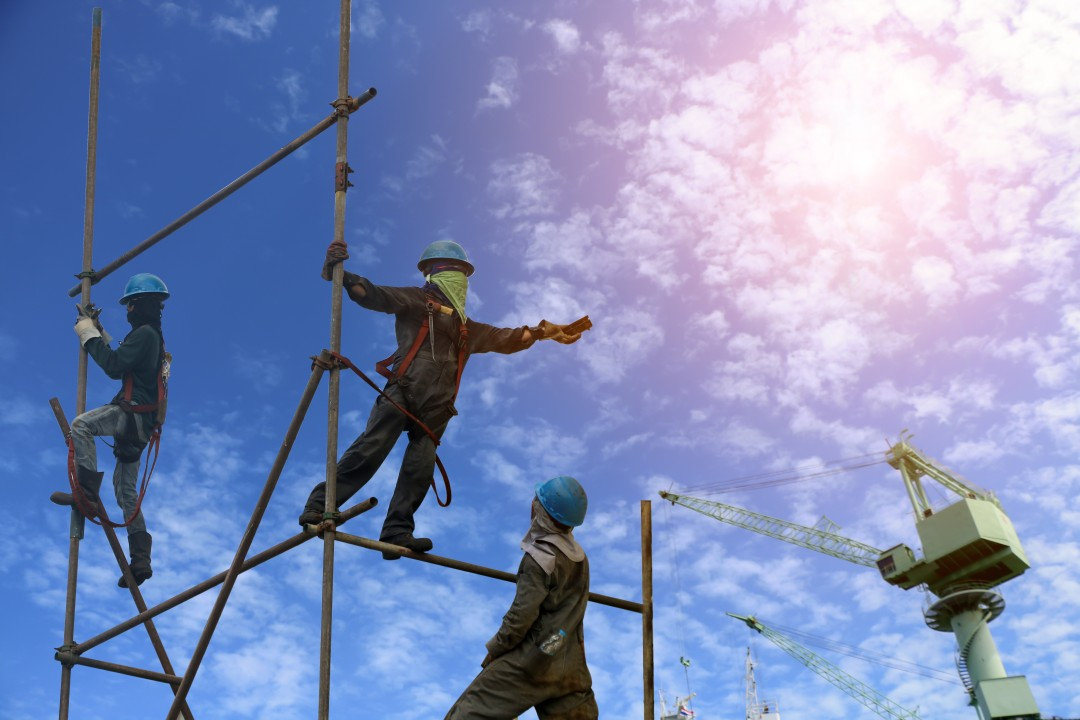Assistant Scaffolder – System ( 6 month course)
Assistant Scaffolder – System click here
Brief Job Description
Assistant Scaffolder – System is responsible for providing assistance in erection, dismantling, and
maintenance of various types of customized system scaffold.
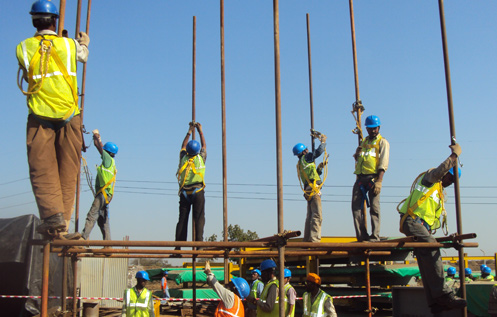
Personal Attributes
The individual is expected to be physically fit and able to work across various locations in withstanding
extreme conditions while working. The person should be able to work within a team to handle various
scaffolding tools tackles, materials, components and works under continuous instruction and close
supervision.
Assist in erection and dismantling of scaffold using pipe and coupler
Description
This unit describes the skills and knowledge required to provide support in erection and dismantling of
scaffold using pipe and coupler under instructions and close supervision.
Scope
The scope covers the following :
Carry out preparatory work for erection of scaffold using pipe and coupler
Erect and maintain scaffold using pipes, couplers and provide necessary assistance
Dismantle scaffold and provide necessary assistance
Elements and Performance Criteria
Carry out preparatory work for erection of scaffold using pipe and coupler
To be competent, the user/individual on the job must be able to:
PC1. prepare base by leveling and compacting ground for erection of scaffold
PC2. select, shift and stack required quantity of materials, components at work location as per the
instructions
PC3. barricade the working area and fix guard rails, safety nets for safe working conditions
PC4. assist in marking, transferring of levels from reference points using water level tube
PC5. check condition of coupler, pipes and fixtures for any bend and deviation from shape
Erect and maintain scaffold using pipes, couplers and provide necessary assistance
To be competent, the user/individual on the job must be able to:
PC6. select swivel coupler, right angle coupler (fixed coupler) based on requirements of scaffold
fixing
PC7. select pipes based on nominal bore diameter and length and check for any bend in pipes
PC8. erect scaffold using pipes and coupler in a sequential manner and provide necessary support
using suitable components as per the instructions
PC9. fix coupler, clamps tightly as per the instructions
PC10. assist in aligning and providing support to scaffold as per the instructions
PC11. assist in checking verticality of scaffold
PC12. place and fix appropriate plank board / walk boards, guard rail, toe board and other
accessories for working
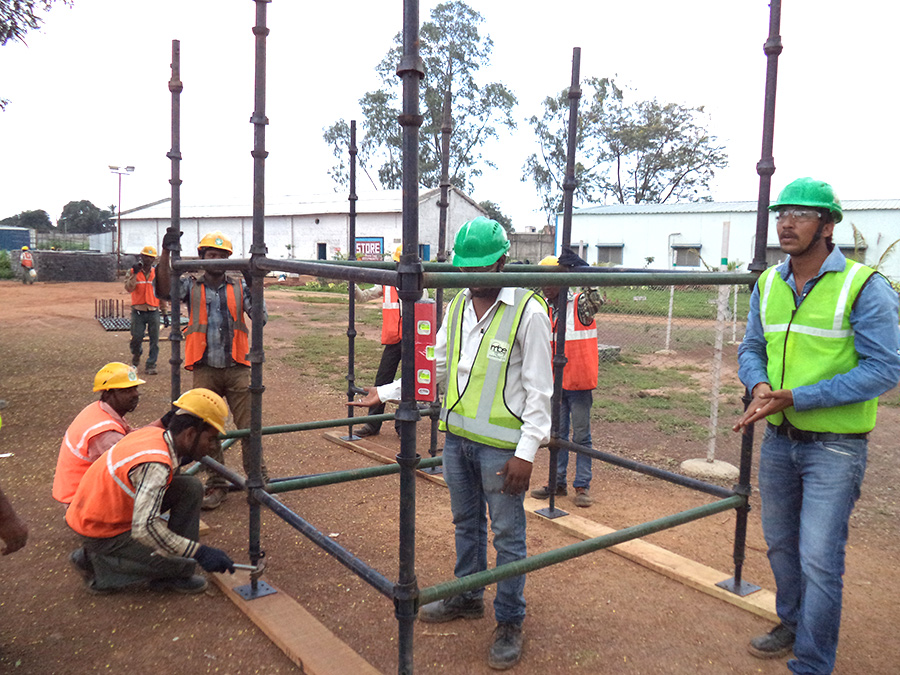
Dismantle scaffold and provide necessary assistance
To be competent, the user/individual on the job must be able to:
PC13. assist in dismantling of scaffold in a sequential manner safely under instructions
PC14. lower scaffold materials in safe manner
PC15. clean and scaffold materials for further use
PC16. follow standard safety procedure and housekeeping practices
Knowledge and Understanding (KU)
The individual on the job needs to know and understand:
KU1. safety rules and regulations for handling and storing shuttering and scaffolding tools,
materials and components
KU2. personal protection including use of safety gears and equipment’s
KU3. safe working methods and movements while performing relevant tasks
KU4. request procedure for tools, materials and equipment’s
KU5. housekeeping & other site administrative rules
KU6. units of measurements
KU7. use of measurements and marking tools
KU8. use of hand tools for carrying out scaffolding works
KU9. standard size of hand tools
KU10. standard size of components
KU11. use of slings, shackles, and belts for lifting and shifting of scaffold materials
KU12. how to provide support to scaffolding
KU13. different types of ropes, their diameter and applicability
KU14. how to tie various types of knots and its use
KU15. how to check for defect in bamboo / ballis
KU16. standard procedure for erection and dismantling of conventional scaffold
KU17. knowledge about storing and handling technique of tools
KU18. knowledge about upkeep, repair and maintenance of tools
KU19. use of personal protective gears
KU20. standard procedure for housekeeping
Generic Skills (GS)
User/individual on the job needs to know how to:
GS1. write in one or more language, preferably the local language at the site
GS2. read in one or more language, preferably the local language at the site
GS3. read instructions, guidelines, sign boards, safety rules & safety tags instructions related to
exit routes during emergency at the workplace
GS4. speak in one or more language, preferably in one of the local languages of the site
GS5. listen and follow instructions given by superior
GS6. orally and effectively communicate with the team members
GS7. decide whether his workplace is safe for working
GS8. plan self-work under the instructions given by superior
GS9. complete work as per agreed time schedule and quality
Assist in erection and dismantling of common customized system scaffold
Description
This unit describes the skills and knowledge required to provide support in erection and dismantling of
common customized system scaffold under instructions and close supervision
Scope
The scope covers the following :
Carry out preparatory works for erection of common customized system scaffold
Erect and maintain common customized system scaffold and provide necessary assistance
Dismantle common customized system scaffold and provide necessary assistance
Elements and Performance Criteria

Carry out preparatory works for erection of common customized system scaffold
To be competent, the user/individual on the job must be able to:
PC1. prepare base by levelling and compacting ground for erection of scaffold
PC2. select, shift and stack required quantity of materials, components at work place as per
instructions
PC3. barricade working area and fix guard rails, safety nets for safe working conditions
PC4. assist in marking, transferring of levels from reference points using water level tube
PC5. visually check tools and components prior to use and report if needs to be changed
Erect and maintain common customized system scaffold and provide necessary assistance
To be competent, the user/individual on the job must be able to:
PC6. select components based on type of scaffold used
PC7. place sole board/base plates on ground as per marking
PC8. fix correct fixtures and components as per system and instructions
PC9. erect scaffold in a sequential manner and provide necessary support as per instructions
PC10. shift components from lower level to upper level using suitable lifting tools and equipment’s
PC11. assist in aligning and providing support to scaffold as per instructions
PC12. assist in checking verticality of scaffold
PC13. place and fix appropriate plank board / walk boards, guard rail, toe board and other
accessories for working platform
Dismantle common customized system scaffold and provide necessary assistance
To be competent, the user/individual on the job must be able to:
PC14. assist in dismantling of scaffold in a sequential manner safely under instructions
PC15. lower scaffold materials in safe manner
PC16. clean and store scaffold materials for further use
PC17. follow standard safety procedure and housekeeping practices
Knowledge and Understanding (KU)
The individual on the job needs to know and understand:
KU1. safety rules and regulations for handling and storing shuttering and scaffolding tools,
materials and components
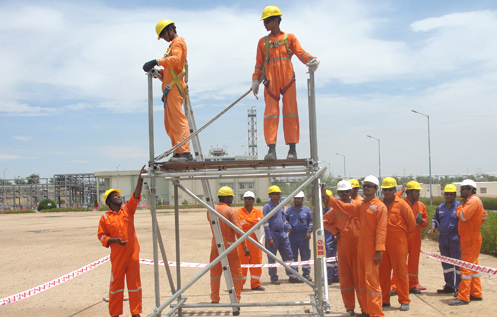
KU2. personal protection including use of safety gears and equipment’s
KU3. safe working methods and movements while performing relevant tasks
KU4. request procedure for tools, materials and equipment’s
KU5. housekeeping & other site administrative rules
KU6. units of measurements
KU7. use of measurements and marking tools
KU8. use of hand tools for carrying out scaffolding works
KU9. standard size of hand tools
KU10. standard size of components
KU11. use of slings, shackles, and belts for lifting
KU12. how to provide support to scaffolding
KU13. different types of ropes, their diameter and applicability
KU14. different types of scaffold ( tubular and frame scaffold) and their use
KU15. maintenance of safe erected scaffold
KU16. how to check for verticality and alignment of scaffold
KU17. knowledge about storing and handling technique of tools
KU18. knowledge about upkeep, repair and maintenance of tools
KU19. use of personal protective gears
KU20. standard procedure for housekeeping
Generic Skills (GS)
User/individual on the job needs to know how to:
GS1. write in one or more language, preferably the local language at the site
GS2. read in one or more language, preferably the local language at the site
GS3. read instructions, guidelines, sign boards, safety rules & safety tags instructions related to
exit routes during emergency at the workplace
GS4. speak in one or more language, preferably in one of the local languages of the site
GS5. listen and follow instructions given by superior
GS6. communicate orally and effectively communicate with the team members
GS7. decide whether his workplace is safe for working and also his work is not creating hazardous
conditions for other
GS8. plan self-work under the instructions given by superior
GS9. complete work as per agreed time schedule and quality
GS10. provide support to erected scaffold
Work effectively in a team to deliver desired results at the workplace
Description
This unit describes the skills and knowledge required to work effectively within a team to achieve the
desired results
Scope
The scope covers the following :
Interact and communicate effectively with co-workers, superiors and sub-ordinates across different
teams
Support co-workers, superiors and sub-ordinates within the team and across interfacing teams to
ensure effective execution of assigned task
Elements and Performance Criteria
Interact and communicate in effective and conclusive manner
To be competent, the user/individual on the job must be able to:
PC1. pass on work related information/ requirement clearly to the team members
PC2. inform co-workers and superiors about any kind of deviations from work
PC3. address the problems effectively and report if required to immediate supervisor appropriately
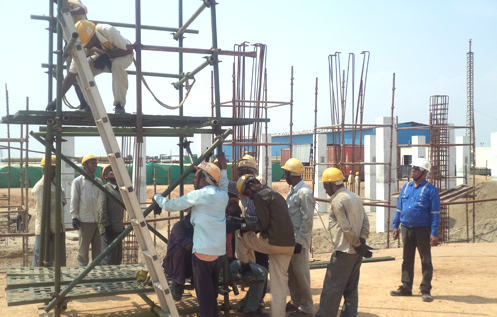
PC4. receive instructions clearly from superiors and respond effectively on the same
PC5. communicate to team members/subordinates for appropriate work technique and method
PC6. seek clarification and advice as per the requirement and applicability
Support co-workers to execute project requirements
To be competent, the user/individual on the job must be able to:
PC7. hand over the required material, tools tackles, equipment and work fronts timely to interfacing
teams
PC8. work together with co-workers in a synchronized manner
Knowledge and Understanding (KU)
The individual on the job needs to know and understand:
KU1. own roles and responsibilities
KU2. importance of effective communication and establishing strong working
KU3. risks of a failure in teamwork in terms of effects on project outcomes, timelines, safety at the
construction site, etc.
KU4. different modes of communication, and its appropriate usage
KU5. importance of creating healthy and cooperative work environment among the gangs of
workers
KU6. different activities within his work area where an interaction with other workers is required
KU7. applicable techniques of work, properties of materials used, tools and tackles used, safety
standards that co- workers might need as per the requirement
KU8. importance of proper and effective communication and the expected adverse
KU9. importance and need of supporting co-workers facing problems for smooth
Generic Skills (GS)
User/individual on the job needs to know how to:
GS1. write in at least one language, preferably in the local language of the site
GS2. read in one or more languages, preferably the local language of the site
GS3. read communication from team members regarding work completed, materials used, tools
and tackles used, support required
GS4. speak in one or more languages, preferably in one of the local language of the site
GS5. listen and follow instructions / communication shared by superiors/ co-workers regarding
team requirements or interfaces during work processes
GS6. orally communicate with co-workers regarding support required to complete the respective
work
GS7. decide on what information is to be shared with co-workers within the team or from
interfacing gang of workers
GS8. plan work and organize required resources in coordination with team members
GS9. complete all assigned task in coordination with team members
GS10. take initiative in resolving issues among co-workers or report the same to superiors
GS11. ensure best ways of coordination among team members
GS12. communicate with co-workers considering their educational / social background
GS13. evaluate the complexity of task and determine if any guidance is required from superiors
Work according to personal health, safety and environment protocol at construction site
Description
This NOS covers the skill and knowledge required for an individual to work according to personal health,
safety and environmental protocol at construction site
Scope
The scope covers the following :
Follow safety norms as defined by organization
Adopt healthy & safe work practices
Implement good housekeeping and environment protection process and activities
Elements and Performance Criteria
Follow safety norms as defined by organization
To be competent, the user/individual on the job must be able to:
PC1. identify and report any hazards, risks or breaches in site safety to the appropriate authority
PC2. follow emergency and evacuation procedures in case of accidents, fires, natural calamities
PC3. follow recommended safe practices in handling construction materials, including chemical
and hazardous material whenever applicable
PC4. participate in safety awareness programs like Tool Box Talks, safety demonstrations, mock
drills, conducted at site
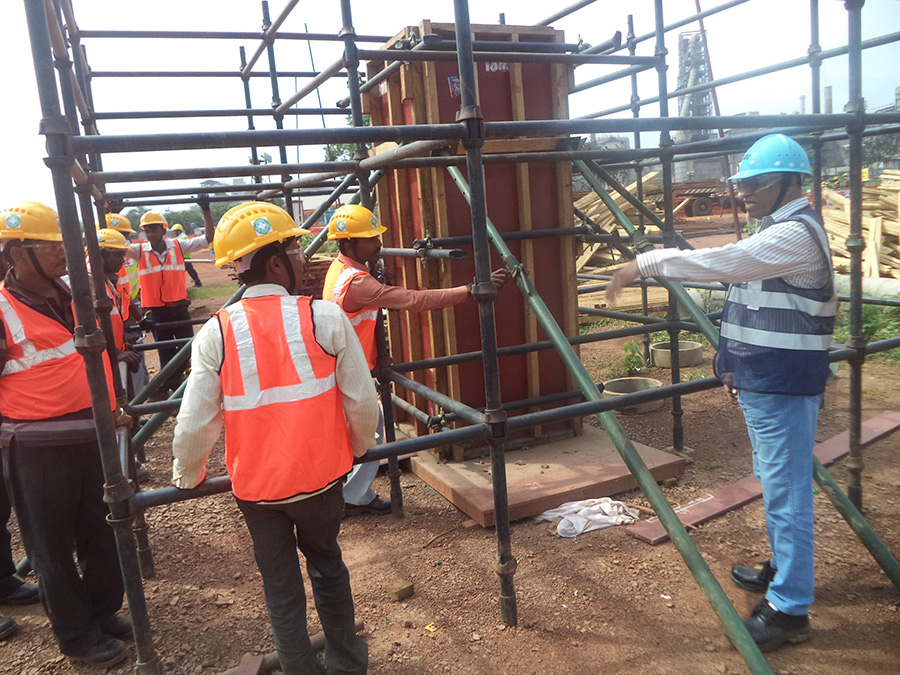
PC5. select and operate different types of fire extinguishers corresponding to types of fires as per
EHS guideline
PC6. identify near miss , unsafe condition and unsafe act
Adopt healthy & safe work practices
To be competent, the user/individual on the job must be able to:
PC7. use appropriate Personal Protective Equipment (PPE) as per work requirements including:
Head Protection (Helmets), Ear protection Fall Protection, Foot Protection, Face and Eye
Protection, Hand and Body Protection, Respiratory Protection (if required)
PC8. handle all required tools, tackles , materials & equipment safely
PC9. follow safe disposal of waste, harmful and hazardous materials as per EHS guidelines
PC10. install and apply properly all safety equipment as instructed
PC11. follow safety protocol and practices as laid down by site EHS department
PC12. undertake and pass height pass test as per EHS guideline
Implement good housekeeping practices
To be competent, the user/individual on the job must be able to:
PC13. collect and deposit construction waste into identified containers before disposal, separate
containers that may be needed for disposal of toxic or hazardous wastes
PC14. apply ergonomic principles wherever required
Knowledge and Understanding (KU)
The individual on the job needs to know and understand:
KU1. reporting procedures in cases of breaches or hazards for site safety, accidents, and
emergency situations as per guidelines
KU2. types of safety hazards at construction sites
KU3. basic ergonomic principles as per applicability
KU4. the procedure for responding to accidents and other emergencies at site
KU5. use of appropriate personal protective equipment to be used based on various working
conditions
KU6. importance of handling tools, equipment and materials as per applicable
KU7. health and environments effect of construction materials as per applicability
KU8. various environmental protection methods as per applicability
KU9. storage of waste including the following at appropriate location: non-combustible scrap
material and debris, combustible scrap material and debris, general construction waste and
trash (non-toxic, non-hazardous), any other hazardous wastes and any other flammable
wastes
KU10. how to use hazardous material, in a safe and appropriate manner as per applicability
KU11. types of fire
KU12. procedure of operating different types of fire extinguishers
KU13. safety relevant to tools, tackles, & requirement as per applicability
KU14. housekeeping activities relevant to task
Generic Skills (GS)
User/individual on the job needs to know how to:
GS1. write in at least one language, preferably in the local language of the site
GS2. fill safety formats for near miss, unsafe conditions and safety suggestions
GS3. read in one or more language, preferably in the local language of the site
GS4. read sign boards, notice boards relevant to safety
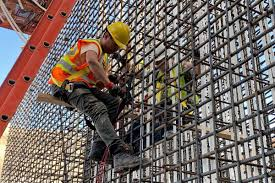
GS5. speak in one or more language, preferably in one of the local language of the site
GS6. listen instructions / communication shared by site EHS and superiors regarding site safety,
and conducting tool box talk
GS7. communicate reporting of site conditions, hazards, accidents, etc.
GS8. not create unsafe conditions for others
GS9. keep the workplace clean and tidy
GS10. identify safety risks that affect the health, safety and environment for self and others
working in the vicinity, tackle it if within limit or report to appropriate authority
GS11. assess and analyze areas which may affect health, safety and environment protocol on the
site
GS12. ensure personal safety behavior GS13. respond to emergency

